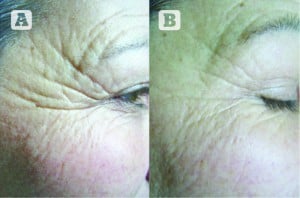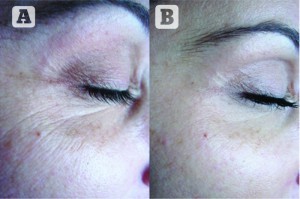In today’s competitive medical aesthetics market, physicians want to hold onto their existing patients and attract new patients by offering a full menu of minimally-invasive services. This is where Pellevé comes in. This versatile, non-invasive treatment can be an important addition to a clinic or medical spa. It is safe, comfortable, and patients actually enjoy the treatment and are satisfied with the results they can achieve.
The Pellevé® Wrinkle Reduction system from Ellman International uses advanced radiofrequency (RF) technology with GlideSafe® handpieces to deliver energy to the deep dermal tissues, inducing collagen contraction and neocollagenesis. This creates contraction of the skin, tightening the deep supporting structures, thus reducing wrinkles and firming loose skin. Some results can be seen immediately after treatment with further tightening over the next 6 months. The new collagen production improves skin texture, tone, and laxity.
Four sizes of GlideSafe handpieces allow physicians to customise the treatment for each patient and different areas of the face. The compact ergonomic design enables practitioners to comfortably manoeuvre around contours, including areas that are difficult to access, such as the periorbital region.
Pellevé has proven to be a useful adjunct for patients who desire a comfortable and affordable procedure with no downtime and appreciable results.
The ageing eyelids
Pellevé can be used to treat the whole face, including the delicate eye area. It can reduce the signs of ageing in the upper face in several ways; periorbital wrinkles, glabellar folds, upper eyelid hooding, forehead wrinkles, crow’s feet, and upper cheeks can all benefit from the tightening and collagen building that Pellevé delivers.
As Oculofacial Surgeon Scott Goldstein, MD, in Philadelphia, PA, says, ‘Clearly the periocular skin is the first area of the face to show visible ageing changes. Many patients come in wanting to reverse these early signs. Pellevé gradually heats up the skin and contracts the protein matrix leading to improvement of fine lines and wrinkles both in the short term based on the initial contraction, and by stimulating collagen production over weeks and months. It is especially effective around the eyes.’

(A) Before treatment, and (B) 60 days after the 5th Pellevé treatment (Images courtesy of Igor Jeremić, MD)
As with all energy-based treatments, patient selection is an important factor. The best candidates, said Goldstein, are ‘patients between ages 30 and 60 who have healthier collagen as a starting point.’
Plastic Surgeon Miles Graivier, MD, in Atlanta, GA, adds, ‘Ideal candidates are people with mild wrinkles in the lower eyelids and crow’s feet and early skin laxity in the brow and upper eyelids. My patients are often people who have some aversion to neurotoxin use in the area and do not want any downtime associated with laser resurfacing.’
No single procedure can repair everything for every patient and tailoring a treatment plan to meet each individual’s needs is key. Goldstein explains, ‘Ageing is a multi-dimensional process with many factors and no one approach works for everyone. Skincare products for home maintenance are a must. As I work my way up the treatment ladder, Pellevé with botulinum toxin and fillers are my next step. We can target any area that needs rejuvenating for mild to moderate wrinkles and laxity.’
Pellevé rates high with clinics based on patient satisfaction. ‘Patients love the benefits and also the relaxation they achieve during the treatment itself. Pellevé sells itself. We now offer or introduce Pellevé to any patients who could benefit from the treatments,’ said Petoskey, Michigan Ophthalmologist Timothy S. Jarvi, MD.
Washington DC Dermatologist Cheryl Burgess, MD, recommends a course of four or five treatments reaching temperatures of 40–42°C. A full face treatment takes less than an hour, and the periocular region can take 15–30 minutes. Although some patients see improvement in a single treatment session, Pellevé is typically performed in a series of two to three treatments that are spaced about 1 month apart, with maintenance treatments as needed.

(A) Before treatment, and (B) 60 days after the 4th Pellevé treatment (Images courtesy of Igor Jeremić, MD)
‘Pellevé fits well into the paradigm of non-invasive rejuvenation,’ says Goldstein. ‘The key is to make sure the patient understands that as a non-ablative treatment, it takes several treatments and time to see the results. I take before and after photos since the gradual improvement occurs over several months and they often forget where they started.’
A significant advantage is that Pellevé can be safely delegated to physician extenders. ‘With appropriate training by the company and physician, nurses and physician assistants can be trained to treat patients,’ says Burgess.
This provides clinics with an additional income stream without taking time away from a busy practice or affecting the doctor’s use of time. ‘Pellevé is the number one income-generating device in my practice,’ she says.
‘When I initially brought in Pellevé, I performed all the procedures myself. However, it was much more cost-effective to train my staff and have one or two key people doing the treatments while I am in the office seeing patients,’ says Goldstein.
Surgical versatility adds value
The versatility of the Ellman device adds a new dimension to an aesthetic clinic, and provides excellent value to practitioners.
According to Goldstein, ‘The Pellevé System has been a great addition to my practice. It really is a multifunctional device with outstanding versatility. I can use the Ellman system in many ways. As a surgical generator, I use it to help with biopsies and excision of skin lesions in the face and periocular area with quick healing, negligible scarring, and excellent patient satisfaction.’
Goldstein uses the surgical applications of the Pellevé generator for all of his cosmetic blepharoplasties. ‘This has been truly a great improvement over scalpel and scissor surgery. The ease of dissecting and developing tissue planes with less bleeding has sped up my cases. The end result is less tissue trauma intraoperatively which translates into less postoperative oedema, less bruising, and much quicker healing.’
According to Jarvi, ‘We use the surgical capabilities of the Pellevé system every day we do surgery, for excisions of seborrhoeic keratosis to epilation of eyelashes and blepharoplasty. We appreciate the ease of use and the control of haemostasis it give us. It has worked well for all our surgical needs.’
‘Pellevé has been useful in tightening the periocular skin in patients with minimal eyelid laxity or those who are not surgical candidates. We can achieve 2–3 mm improvement of eyelid laxity or crow’s feet lines about the eyes,’ says Burgess. ‘Etched lines at rest respond best to Pellevé. Hyperkinetic lines are usually treated with botulinum toxin A.’
Pellevé also plays a role as a maintenance therapy post blepharoplasty. As Graivier says, ‘It can be used in patients with previous blepharoplasty who wish to do later ‘maintenance’ or skin tightening without any downtime or discomfort. Pellevé can add some additional skin tightening, especially in patients who had a transconjunctival approach. It can also be offered in the years post-op as a maintenance and skin tightening treatment.’
Jarvi agrees. ‘We have been using Pellevé for lower lids that need some tightening post-lateral tarsal strips, and after an upper blepharoplasty to improve the lower lids.’
By adding Pellevé, says Goldstein, ‘You start to see how this investment really pays off for practitioners with medical/cosmetic blended practices and those with exclusively cosmetic practices. It’s a natural fit for patients who want to come in and get out with no downtime, but still get results. They come in for Pellevé on one visit, and then filler injections and more. It helps develop loyalty and trust.’



